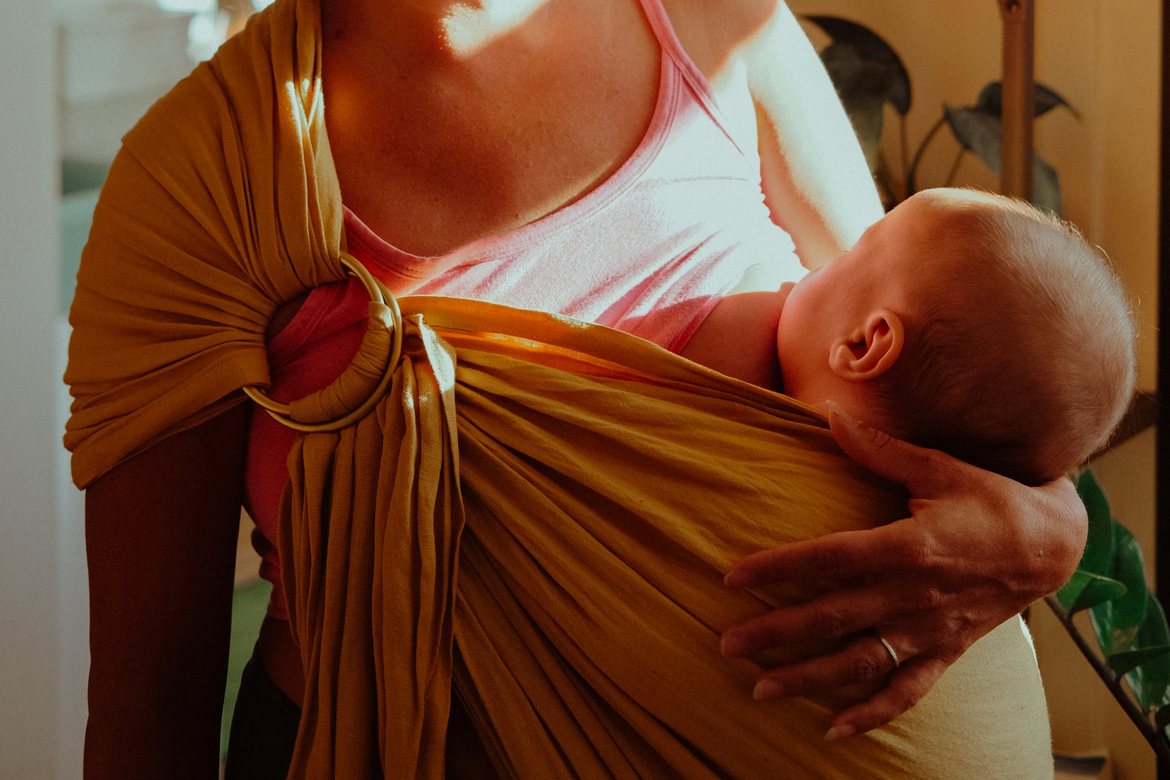By Brooke Maree
Combining these two skills can take some practice and patience. What baby carrier/sling can you use to breastfeed your child in? How can you do it safely? What are the benefits to yourself and your baby (stacks!)? So let’s get straight into some simple guidelines for success.
BEFORE YOU START
The golden rule is: Breastfeeding is a skill on its own, as is babywearing. Make sure you feel confident with each one individually FIRST before you attempt combining them.
BENEFITS
For you: convenience + a discreet way of feeding.
Feeding your child while carrying them can be extremely convenient as it means not having to stop what you’re doing, take them out of the baby carrier, find somewhere comfortable to feed them, put them back in, and then keep going. Feeding on the go means getting from A to B WHILST meeting your child’s needs- WIN!
Now, it’s your legal right to get your boob out and feed your beautiful baby ANYWHERE and ANYTIME you wish, so don’t ever feel like you need to be discreet. All power to you. However, if you feel more comfortable within yourself to be a bit more modest OR your child feeds better without distraction, then you might find feeding in a carrier offers some more privacy. People can sometimes hardly notice you’ve got a child attached to your nipple and if you add the hood/fabric safely for more coverage, then you’ve got a whole breastfeeding cover happening too! *Please always monitor you child and make sure their airway is clear and not obstructed by any fabric* Further to positioning, feeding in an upright position helps create an ‘active feeding’ environment for your baby.
For baby: soothing, good positioning, + digestion improvement.
Walking around with your child in a baby carrier or sling creates a relaxed environment for them as they are soothed by the gentle motion and sway of your steps. It calms them down and usually makes them feel quite content. If you have a child who on the breast naturally arches their back and throws their head around, attempting to feed them whilst in a calm soothing environment could help them to relax.
Dr. Sears recommends feeding a child like this if they are ‘problem suckers’. Getting your child to relax muscles it doesn’t need in turn allows them to concentrate on the muscles they do need to feed successfully from the breast.
Further to positioning, feeding in an upright position helps create an ‘active feeding’ environment for your baby. Rather than manually holding them and placing them on the breast, feeding upright on the go allows for a greater opportunity of self-attachment, meaning your baby might enjoy their meal more by feeling like they have the ability to come on and off as they please and latch on with their own control.
This upright position also aids your baby’s immature digestion system, which sometimes appreciates the help of getting the liquid through the system and out the back door! Thanks to our friend gravity, feeding in a baby carrier helps the physiological process of digestion and peristalsis, which is where the muscles contract to move liquid and solids through the body.
Getting your baby in the right carrier/wrap can be your individual road to success.
Lastly, the final major benefit is that it can boost milk production! Having your child in close proximity to your breast means you will more than likely feed them more often with their beautiful senses heightened with the smell of your milk, and the touch of your chest. This promotes your baby gaining healthy weight quicker, as they will be encouraged to feed more frequently, and you will be able to respond to their cues more. (If you want to avoid this last benefit of frequent feeding, pass the baby carrier to your partner or friend  !)
!)
HOW IT CAN BE DONE
Getting your baby in the right carrier/wrap can be your individual road to success. What will work for some will not work as well for others. You and your baby will have your preferences and there are some important points to consider when feeding your baby in certain carriers/slings.
Woven Wrap & Stretchy Wraps – These aren’t the most ideal solution. A stretchy wrap is best avoided because the nature of the ‘stretch’ in the fabric means that your baby should remain tight and with 3 layers of fabric over them at all times. It is my recommendation that you don’t loosen a stretchy wrap to feed in because of a minor fall hazard and the possibility of your baby slumping. Instead, once you take baby out, leave the wrap on and use it simply as an aid to support baby and take some pressure off your arms. A Woven Wrap is not stretchy in nature so you are able to feed better in this. You could try a Front Wrap Cross Carry off-centre on the preferred breast or a traditional hip carry with a slip knot that allows you to loosen baby down and tighten up. All-in-all, feeding in a woven wrap will generally take some adjustment and isn’t super straight forward. You can set a carry up to feed in but then once finished you will need to re-do the wrap in a new carry to continue using it in a safe way.











